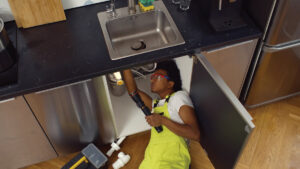 Manufactured homes, sometimes dubbed mobile homes, often log disproportionately higher energy bills than traditional wood-frame or modular homes. But you can take steps to help manage energy costs and increase comfort.
Manufactured homes, sometimes dubbed mobile homes, often log disproportionately higher energy bills than traditional wood-frame or modular homes. But you can take steps to help manage energy costs and increase comfort.
Manufactured homes come in several configurations: singlewide, doublewide and triplewide. Doublewides and triplewides require a crossover duct to provide air flow between the sections – a major culprit in air leaks that contribute significantly to wasted energy.
Manufactured units must also be transported to a site, and movement can disrupt the integrity of the original construction. Also, homes that sit on jack stands or blocks allow air to flow underneath.
There isn’t a magic bullet to lower the energy consumption of a manufactured home. It takes time and hard work to troubleshoot all of the possible causes of energy loss. The most common culprits and ways to remedy them are:
Belly board problems
In most manufactured homes, the belly board holds the insulation in place under the floor and serves as a vapor barrier. Plumbing that runs under the floor is on the warm side of the insulation to keep it from freezing in winter. However, the belly board can be damaged by animals, deteriorate over time, or become torn, allowing the floor insulation to become moisture laden or to simply fall out, exposing ductwork and dramatically increasing energy losses. Often there is also long-term water damage from leaky pipes, toilets, and showers that has compromised floor, insulation and belly board integrity. These problems must be addressed prior to basic weatherization. Replacing the belly board and repairing leaky plumbing should be the first thing on your to do list.
Air leakage/infiltration
Infiltration of excessive outside air can be a major problem. Specific problems include deteriorated weather stripping, gaps in the “marriage wall” that joins multiple units making up the home, holes in the ends of ducts, gaps around wall registers and behind washers and dryers, and unsealed backing to the electrical panel. This is a dirty job and will require you to crawl under the home and into the attic looking for gaps. Gaps can be filled with weather stripping and insulation. You should consult your local hardware store for the exact type of insulation needed for the specific area of the home.
Crossover ducts
Sealing the ducts than run under the sections making up your mobile home will result in tremendous energy savings and increased comfort. Crossover ducts are often made of flexible tubing and are therefore prone to collapse and are easy for animals to chew or claw into. Crossover ducts made of thin sheet metal can leak air heated or cooled air to the great outdoors, which is what happens when ductwork connections are made with duct tape. Repairs are generally easy, using either special duct sealant or metal tape that can be found at most home improvement stores. If you can afford the upgrade, consider replacing a flexible crossover duct with metal ductwork.
Lack of insulation
Insulation levels and associated R-values in walls, floors and ceilings in manufactured homes can be woefully inadequate. If it is easily accessible, adding additional insulation to ceiling and floors will help. However, adding insulation to walls will be a problem without major renovations that are often not cost justified.
Uninsulated ductwork
Ductwork itself may not be wrapped with insulation, allowing heating and cooling losses. Wrapping ductwork will lead to energy savings. You should be able to find insulation specifically made for ductwork at your local hardware store.
Single-glazed windows and uninsulated doors
Most manufactured homes come with single-glazed windows and uninsulated doors, which have a low R-value. That means the rate of heat transfer between finished interior spaces and the outdoors is higher than what’s ideal. Replacing the windows with double- or triple-glazed windows or adding storm windows will help to make the home more comfortable. An insulated door will also help. However, these solutions can be very expensive. At a minimum, you should add weather stripping to doors and windows. Also, a window film kit is a cheap and easy-to-install upgrade that will help to keep winter winds out of the home.
It may take a couple of weekends and a few hundred dollars, but basic repairs can see significant savings. Savings of up to 50 percent have been reported in manufactured homes that have been properly sealed and had old electric furnaces replaced with new electric heat pumps. The key is to get out there and start hunting for the savings lurking under and inside your manufactured home.
Source: Brian Sloboda is a program manager specializing in energy efficiency for the Cooperative Research Network, a service of the Arlington, Va.-based National Rural Electric Cooperative Association.
How to tell if you can benefit from improving your home’s energy performance:
Your home is a good candidate for upgrades if:
- Your home was built before 1994 (and especially before 1976) and hasn’t been significantly improved or upgraded.
- Your heating, cooling, or water heating equipment breaks down a lot.
- You feel drafts inside on windy days.
- The air near the floor is significantly cooler than the air near the ceiling.
- You have to wait a long time for hot water, and water cools off quickly between uses.
- You have to set the thermostat below 70 to stay cool in the summer.
- You have trouble keeping your home warm in winter or cool in summer.
- There are large fluctuations in your utility bills from month to month, and especially from the same month of the previous year.
- There is condensation on the inside surface of your windows in the winter.
Source: U.S. Department of Housing and Urban Development Manufactured Homes : Saving Money by Saving Energy www.huduser.org








